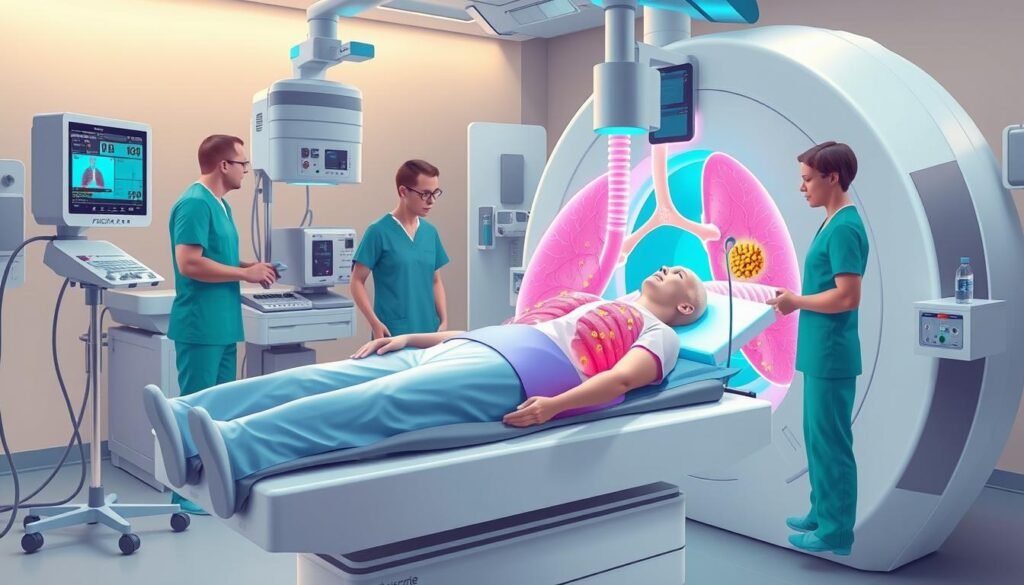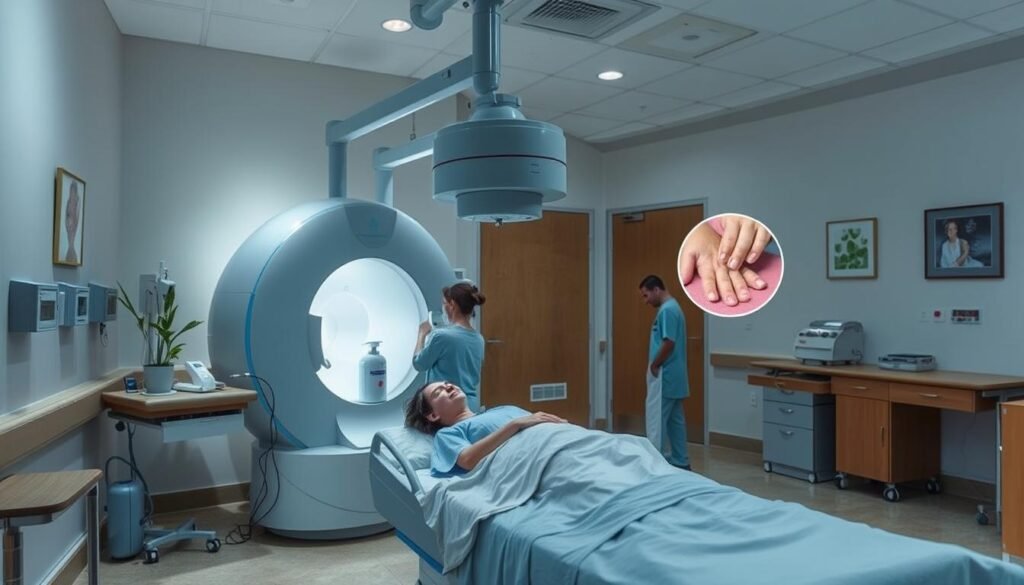Did you know that nearly 80% of those with lung cancer will have radiation therapy? It’s key in treating non-small cell lung cancer (NSCLC). It might be the main treatment or part of a bigger plan. Knowing all about radiation therapy can really help with patient results and comfort.
This treatment guide shines a light on how radiation therapy works. It talks about the different types, how it’s used, and side effects. With this info, patients and families can get ready for what lies ahead. Learn about the available radiation therapies and what happens during and after treatment. This guide gives essential details for anyone dealing with NSCLC.
Key Takeaways
- Radiation therapy is commonly applied in various stages of NSCLC treatment.
- External beam radiation therapy is typically administered 5 days a week for 5 to 7 weeks.
- Brachytherapy can be a quick option, often taking less than 30 minutes for treatment.
- Side effects may include skin reactions, nausea, and fatigue, varying by treatment location.
- Regular follow-up appointments post-treatment help manage late side effects and monitor health.
Understanding Non-Small Cell Lung Cancer (NSCLC)
Non-small cell lung cancer (NSCLC) makes up about 85% of lung cancer cases. It is vital to understand the different types of lung cancer. NSCLC includes subtypes like adenocarcinoma, squamous cell carcinoma, and large cell carcinoma. Each of these has unique features and approaches to treatment.
One key point about NSCLC is its tendency to be diagnosed in later stages. This highlights the need for prompt detection and effective treatments. Staging plays a key role in deciding the prognosis and treatment plans. It measures how far the cancer has spread.
Smoking is the top risk factor for non-small cell lung cancer. Other risk factors include exposure to secondhand smoke, asbestos, and workplace chemicals. Age also plays a significant role in the risk for developing cancer.
What is Radiation Therapy?
Radiation therapy is a key strategy in fighting cancer. It uses high-energy rays to target and kill cancer cells. This approach is based on the idea that these rays can harm the DNA of cancer cells. This stops their growth and multiplication.
The main goal of radiation therapy is to remove tumors. It also aims to protect the healthy cells nearby. People with a type of lung cancer called NSCLC often get this treatment. It can be used before or after surgery and for easing symptoms. The success of radiation therapy for NSCLC depends on the type of rays used, the tumor’s features, and the patient’s general health.
Many side effects can occur from radiation therapy. Common problems include:
- Fatigue: This tends to increase as treatment goes on.
- Hair loss: Mainly in areas such as the brain, neck, or chest.
- Skin changes: This can mean redness, dryness, or itching in the treated area.
- Nausea and vomiting: Often happens with treatment to the brain, pelvis, or stomach.
- Memory issues: This happens to patients treated in the brain area.
Various techniques are used in radiation therapy, like external beam radiation and brachytherapy. Each method is suited for certain cancers or stages. With new technologies, treatments are getting better and side effects are fewer.
Knowing how radiation therapy works in cancer care is important. It helps us understand its benefits and the hurdles. By learning about how it works and its side effects, patients can be better prepared for treatment.
When is Radiation Therapy Used?
Radiation therapy is key in treating non-small cell lung cancer (NSCLC). Knowing when to use radiation boosts its power to heal. This therapy is customized for each person, depending on their health and cancer stage.
At times, radiation is the main treatment for NSCLC. This happens when surgery isn’t viable due to the cancer’s location or severity. It may also follow surgery, called adjuvant therapy, to kill leftover cancer cells. Often, combining radiation with other treatments, like chemotherapy, works best. This mix improves results and helps patients more.
For advanced cancer, radiation eases pain and lifts quality of life. Understanding all ways to use radiation is crucial for doctors and patients.
In treating NSCLC, radiation therapy has a proven role. Over half of cancer patients receive radiation at some point. This shows the importance of knowing when to use radiation.
| Application | Description |
|---|---|
| Primary Treatment | Used when surgery is not viable or available. |
| Adjuvant Therapy | Administered post-surgery to clear remaining cancer cells. |
| Neoadjuvant Therapy | Given before surgery to shrink tumors. |
| Palliative Care | Relieves symptoms for advanced lung cancer patients. |
Choosing radiation therapy means looking closely at the patient’s health. Advice from medical experts helps patients make this big choice in their NSCLC fight.
Types of Radiation Therapy for NSCLC
It’s key to know the different kinds of radiation therapy for treating NSCLC. There are three main types: External Beam Radiation Therapy (EBRT), Brachytherapy, and Proton Therapy. These methods are vital for effective lung cancer management.
EBRT uses high-energy beams aimed at cancer from outside the body. It can work alone or with other treatments like chemotherapy. This boosts its power by shrinking tumors before surgery or killing off any remaining cancer cells. EBRT’s advanced techniques, like Intensity Modulated Radiation Therapy (IMRT), target radiation doses precisely, saving healthy tissue.
Brachytherapy, set aside for when tumors block airways, puts radioactive material near the tumor. This delivers a strong dose directly, shrinking or removing the tumor. It does this while sparing nearby healthy tissue.
Proton Therapy offers unique benefits, though it’s less common. It uses protons, not the usual x-rays, to zone in on cancer. This cuts down on damage to other organs and lessens the chance of issues like lung scarring or heart problems.
Knowing about these types of radiation therapy helps patients talk about NSCLC treatments with their doctors. For more info, check out this page.
External Beam Radiation Therapy (EBRT)
External Beam Radiation Therapy (EBRT) is a key treatment for Non-Small Cell Lung Cancer (NSCLC). It uses high-energy beams to fight cancer cells. At the same time, it tries to protect healthy tissue nearby. A team of specialists, including a radiation oncologist and others, works together for safe and effective treatment.
How EBRT Works
First, patients have simulation sessions. These can take 30 minutes to 2 hours. They involve imaging scans to find where to aim the radiation. Patients might get skin markings or tattoos to help with positioning. This step is vital for good results.
Next, treatment sessions usually take 15 to 30 minutes. Most of this time goes to placing the patient just right. Then, the radiation is given. Treatments are often done daily, Monday through Friday, and can last two to eight weeks. The goal is to kill cancer cells bit by bit while letting healthy tissue heal.
Newer Techniques in EBRT
Technology has improved EBRT a lot. Now, we have Stereotactic Body Radiation Therapy (SBRT) and Intensity Modulated Radiation Therapy (IMRT). These methods are more accurate, targeting tumors closely and sparing more healthy tissue. For example, SBRT can deliver a high dose in one session, great for localized tumors. These advances aim to get better results for patients and reduce side effects.
Brachytherapy for NSCLC
Brachytherapy is a big step forward in treating lung cancer, specifically non-small cell lung cancer (NSCLC). This method puts a radioactive source right next to or inside the cancerous tissue. Its main aim is to give a high radiation dose directly to the cancer, while protecting healthy tissue around it.

For NSCLC patients with tumors blocking their airways, brachytherapy can be a key option. It often uses endobronchial brachytherapy. This means radiation is directly applied to the bronchi. Patients typically have three sessions, one week apart, with each lasting 3 to 15 minutes.
Brachytherapy comes in two types: temporary and permanent. Temporary brachytherapy is chosen for lung cancer treatment following tumor removal. High Dose Rate (HDR) brachytherapy is used for tumors in the major bronchi. It’s different from traditional radiation because it’s more focused.
After brachytherapy, doctors check its success with scans or exams. Side effects mainly affect the treatment area. Patients might feel a sore throat, cough, have trouble breathing, or produce more mucus. Brachytherapy can be a stand-alone treatment or part of a broader approach that includes surgery or external radiation. This makes it a flexible choice for lung cancer treatment.
Proton Therapy: An Innovative Option
Proton Therapy is a cutting-edge method that uses protons, not the usual X-rays. It accurately targets tumors. This tech is particularly good for treating a type of lung cancer called NSCLC. It lessens the risk of radiation harming healthy areas, lowering side effects and boosting patient recovery.
It shines when treating cancers close to crucial organs, like the brain and heart. By focusing protons on the tumor, it delivers a strong energy burst only there. This protects the healthy parts. It’s a key choice for those with complex cases, especially stage III NSCLC patients.
Proton therapy also stands out for recurrent cancers, offering new hope where other treatments have failed. It supports continued care for returning tumors. Researchers are looking into ways to make it even better. They’re exploring fast-track methods like Proton FLASH radiotherapy that could shorten treatment times and guard healthy tissue.
However, not everyone can easily get proton therapy due to few centers offering it. This makes insurance issues and limits patient choices. Moffitt Cancer Center and IBA are addressing this. They’re bringing in a compact system named Proteus®ONE. It aims to make proton therapy more accessible, improving care and showing its potential in fighting cancer.
The table below shows how proton therapy and traditional radiation differ for NSCLC treatment:
| Feature | Proton Therapy | Conventional Radiation Therapy |
|---|---|---|
| Tumor Precision | High precision targeting reduces damage to surrounding tissues | Less precise, can affect healthy tissues |
| Side Effects | Lower risk of side effects (fatigue, nausea, skin irritation) | Higher likelihood of side effects due to broader radiation spread |
| Recurrent Tumors | Effective option for recurrent tumors | Limited options after previous treatment |
| Pediatric Application | Reduces risk of long-term developmental issues | Higher risk of secondary tumors in children |
| Availability | Limited number of treatment centers | More widely available |
Side Effects and What to Expect During Radiation Treatment
Treating Non-Small Cell Lung Cancer (NSCLC) with radiation leads to different side effects. These depend on your health, where you’re treated, and how much radiation you get. Knowing what these side effects are can help you prepare. It also makes talking to your doctors easier, which is key to handling these tough times. Below are the usual side effects and tips for managing them.
Common Radiation Side Effects
Here are some side effects people often experience:
- Fatigue: You might feel very tired in a way that’s different from normal. This can last even after your treatment ends.
- Skin Reactions: Your skin might get red, swollen, or blistered. It could look like a sunburn and needs careful treatment.
- Hair Loss: If radiation targets your head, you might lose hair in clumps. Fortunately, it usually grows back after treatment.
- Nausea and Vomiting: This is more likely if your abdomen area receives radiation or with certain treatment combos.
- Diarrhea: This side effect might show up a few days after starting treatment, especially if it’s in the abdominal area.
- Changes in Sex Life and Fertility: Radiation can affect reproductive organs. It’s important to talk to your doctor about how to deal with this.
Managing Radiation Side Effects
There are helpful ways to deal with side effects and keep up your quality of life. Here are some tips:
- Prioritize Rest: Make sure to rest enough and pay attention to what your body needs to fight off fatigue.
- Skin Care: Use gentle skin care products on the treated areas to help with dryness and irritation.
- Meal Planning: Working with a dietitian can help you deal with changes in appetite by creating a personalized nutrition plan.
- Emotional Support: It’s helpful to talk to a counselor or join a support group to manage emotional challenges.
- Stay Hydrated: Drinking lots of fluids can ease symptoms like nausea and is good for your overall health.
| Side Effect | When It Occurs | Management Strategies |
|---|---|---|
| Fatigue | During and after treatment | Rest, reduced activities, hydration |
| Skin Irritation | 1-2 weeks post-treatment start | Moisturizers, gentle cleaning |
| Hair Loss | 2-3 weeks into treatment | Gentle treatment, support groups |
| Nausea | Days after beginning treatment | Medications, small frequent meals |
| Diarrhea | Days after abdominal treatment | Hydration, dietary adjustments |

Coping with Radiation Side Effects
Handling radiation side effects well means being prepared and knowing what problems may come up during treatment. Patients often deal with skin issues and feeling very tired. By using good strategies, patients can feel better and have a better life while getting treated.
Skin Care During Radiation
It is very important to take care of your skin while you’re going through radiation. This helps avoid problems like dryness, itching, peeling, and blistering. The skin where you get treatment can get very sensitive. So, it’s important to follow some key tips:
- Use mild soap and recommended lotions from healthcare providers.
- Avoid extreme temperatures and direct sunlight exposure by wearing sunscreen daily with an SPF of 30 or higher.
- Choose soft, loose clothing to reduce irritation on sensitive skin.
- Keep the skin clean and avoid scrubbing or using abrasive materials.
- Consult with a doctor before using any new products for at least a year after treatment.
For more help on dealing with radiation side effects, especially skin care, visit: Caring for Yourself During Radiation Therapy.
Handling Fatigue from Radiation
Feeling very tired from radiation can make everyday tasks hard. To handle this tiredness, you need a plan that works on many levels:
- Engage in light physical activity to enhance energy without causing exhaustion.
- Prioritize rest by ensuring good sleep hygiene and taking short naps as necessary.
- Maintain a balanced diet that supports tissue repair and energy levels.
- Stay hydrated, which can aid in alleviating feelings of fatigue.
- Seek assistance with daily tasks if feeling overwhelmed.
Telling your healthcare team about any odd symptoms is key for getting the help you need. Many patients find comfort in talking about what they’re going through and getting advice that fits their situation.
Being proactive and well-informed is crucial when dealing with radiation side effects. These strategies help with both skin care and fighting off tiredness. Regular check-ups improve the safety of your treatment and address any issues that might come up during your therapy journey.
Nutrition and Appetite Changes During Treatment
Patients getting radiation often deal with nutrition changes during radiation and appetite issues. These issues might come from side effects like altered taste, sore mouths, or trouble swallowing. To keep up energy and health, it’s crucial to focus on good eating habits throughout treatment.
Eating small meals often instead of three big ones can help manage appetite. This method makes it easier to get enough nutrition. It’s also smart to eat calorie-rich foods to avoid losing weight. Including high-protein foods throughout the day is essential for patients.
| Recommended Soft Diet Foods | Caloric Content |
|---|---|
| Mashed potatoes | Approx. 150 calories (1 cup) |
| Yogurt or kefir drinks | Approx. 150-250 calories (8 oz) |
| Milkshakes or smoothies | Approx. 400 calories |
| ENU Nutritional Shake (8.4 oz) | Over 400 calories |
| Boost/Ensure Plus (8 oz) | 300-400 calories |
For those getting radiation to the head and neck, a soft diet is often best. Choose foods that are high in calories and protein but are also easy to swallow. It’s important to avoid things like citrus, spicy foods, and some fruits that can make the mouth sore.

To get more calories and protein, add extra oil or creamy nut butters to meals. Avocados are also a great choice. Staying hydrated during radiation is very important, too.
Keeping an eye on eating and drinking habits is key. Skipping meals can lead to malnutrition or fatigue. Talking with doctors or dietitians is critical to plan a diet that meets nutritional needs and tackles radiation challenges.
Conclusion
It’s really important to understand radiation therapy if you’re dealing with non-small cell lung cancer (NSCLC). This treatment can directly target cancer cells, making it a key method in fighting the disease. Also, it’s vital to know about the side effects. For instance, up to 95% of patients might get radiation dermatitis or skin problems. Being ready for these issues helps patients cope better and could lead to improved outcomes.
The NSCLC treatment guide focuses on how effective radiation therapy is. It also shows why a team approach in caring for patients is critical. Healthcare workers need to tell patients about side effects like tiredness and eating changes. These can really impact someone’s life. Working together, medical teams can offer strong support throughout the treatment process.
To wrap it up, beating NSCLC takes educating patients and understanding the treatment options well. With the right information and help, people facing NSCLC can manage their treatment well. For more details on radiotherapy, its workings, and side effects, check out valuable resources here. Also, for talks on chemotherapy, look here. It’s a tough road, but with good advice, success is possible.